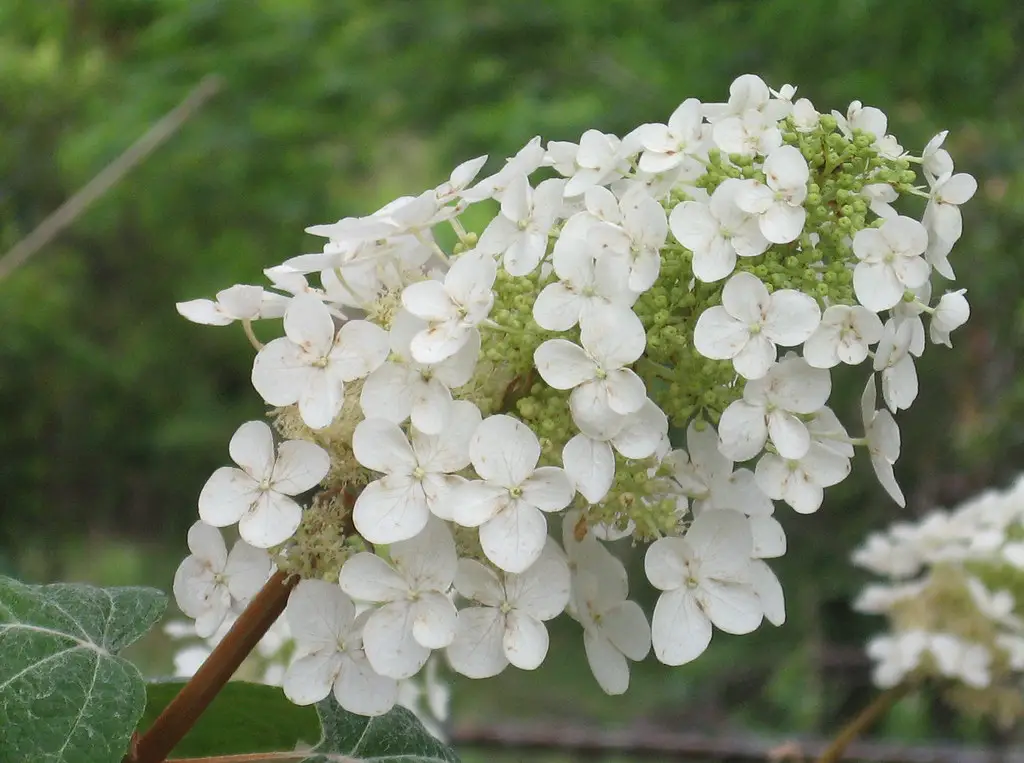The Oak Leaf Hydrangea, with its striking foliage and showy flowers, is a magnificent addition to any garden. Named for its oak leaf-shaped foliage, this hydrangea offers multi-season interest, displaying beautiful white or pink blossoms in the summer and vibrant red or purple leaves in the autumn. Its unique appearance sets it apart from other hydrangea varieties and makes it a favorite among garden enthusiasts.
Native to the southeastern United States, Oak Leaf Hydrangea (Hydrangea quercifolia) is a hardy deciduous shrub that can thrive in various environments. With its graceful conical flower heads and unique leaf texture, it’s not only an excellent focal point but also provides valuable habitat and food for pollinators and other wildlife.
One of the advantages of Oak Leaf Hydrangea is its adaptability. While it prefers certain conditions, it is tolerant of various soils and climates, making it an accessible choice for gardeners in different regions. Whether planted as a single specimen or massed in a border, the Oak Leaf Hydrangea’s presence is always eye-catching and adds significant value to the landscape.
| Attribute | Details |
|---|---|
| Common Names | Oak Leaf Hydrangea |
| Botanical Name | Hydrangea quercifolia |
| Family | Hydrangeaceae |
| Plant Type | Deciduous Shrub |
| Mature Size | 4-8 feet tall, 4-8 feet wide |
| Sun Exposure | Full sun to partial shade |
| Soil Type | Well-drained soil, prefers slightly acidic soil |
| Hardiness Zones | 5-9 |
| Native Area | Southeastern United States |
Oak Leaf Hydrangea Care
Oak Leaf Hydrangeas are relatively easy to care for, thriving in a variety of conditions. They prefer slightly acidic, well-drained soil and benefit from mulching to retain soil moisture and regulate temperature. Though they can tolerate brief periods of drought, they perform best when given consistent moisture, especially during the hot summer months.
These plants are also quite pest-resistant and don’t require much in terms of fertilization. A balanced fertilizer applied in early spring can provide a boost, but over-fertilizing can lead to leafy growth at the expense of blooms. Providing protection from harsh winds and scorching sun can also help maintain the plant’s vibrant colors and overall health.
Light Requirement for Oak Leaf Hydrangea
Oak Leaf Hydrangeas thrive in full sun to partial shade. While they can tolerate a range of light conditions, too much shade can reduce flowering, while excessive sun can scorch the leaves.
Soil Requirements for Oak Leaf Hydrangea
Oak Leaf Hydrangea prefers well-drained soil that is slightly acidic. While it can tolerate other soil types, ensuring the right pH and drainage can lead to more vibrant blooms and healthier growth.
Water Requirements for Oak Leaf Hydrangea
Regular watering, especially during dry spells, is crucial for Oak Leaf Hydrangea. While mature plants are somewhat drought-tolerant, consistent moisture will lead to optimal growth and flowering.
Temperature and Humidity
Oak Leaf Hydrangea can thrive in hardiness zones 5-9. It prefers moderate humidity and temperatures but can adapt to a range of climatic conditions.
Fertilizer
A balanced, slow-release fertilizer applied in early spring can benefit Oak Leaf Hydrangea, but over-fertilizing should be avoided, as it can inhibit blooming.
Pruning Oak Leaf Hydrangea
Pruning is typically unnecessary but can be done to shape the plant or remove dead wood. If desired, prune in late winter or early spring before new growth begins.
Propagating Oak Leaf Hydrangea
Oak Leaf Hydrangea can be propagated through softwood cuttings or division. Taking cuttings in early summer or dividing in winter or early spring can yield successful results.
How To Grow Oak Leaf Hydrangea From Seed
Growing Oak Leaf Hydrangea from seed is possible but more challenging. Stratification and a carefully controlled environment are needed for successful germination.
Common Pests & Plant Diseases
Aphids
Small insects that can be controlled with insecticidal soap or neem oil.
Powdery Mildew
A common fungal issue that can be managed with proper airflow and spacing.
Common Problems With Oak Leaf Hydrangea
Yellowing Leaves
Often caused by overwatering or poor drainage, adjust watering practices and check soil conditions.
Lack of Flowers
May result from excessive fertilization or pruning at the wrong time. Adjust practices as needed.
Pro Tips
- Mulch around the base to retain moisture and protect the shallow roots.
- Plant in a location with morning sun and afternoon shade for optimal growth.
- Avoid planting in areas with strong winds or excessive exposure.
- Monitor soil pH and amend as needed to maintain slight acidity.
- Be patient with newly planted specimens; they may take a year or two to establish.




